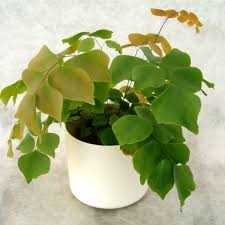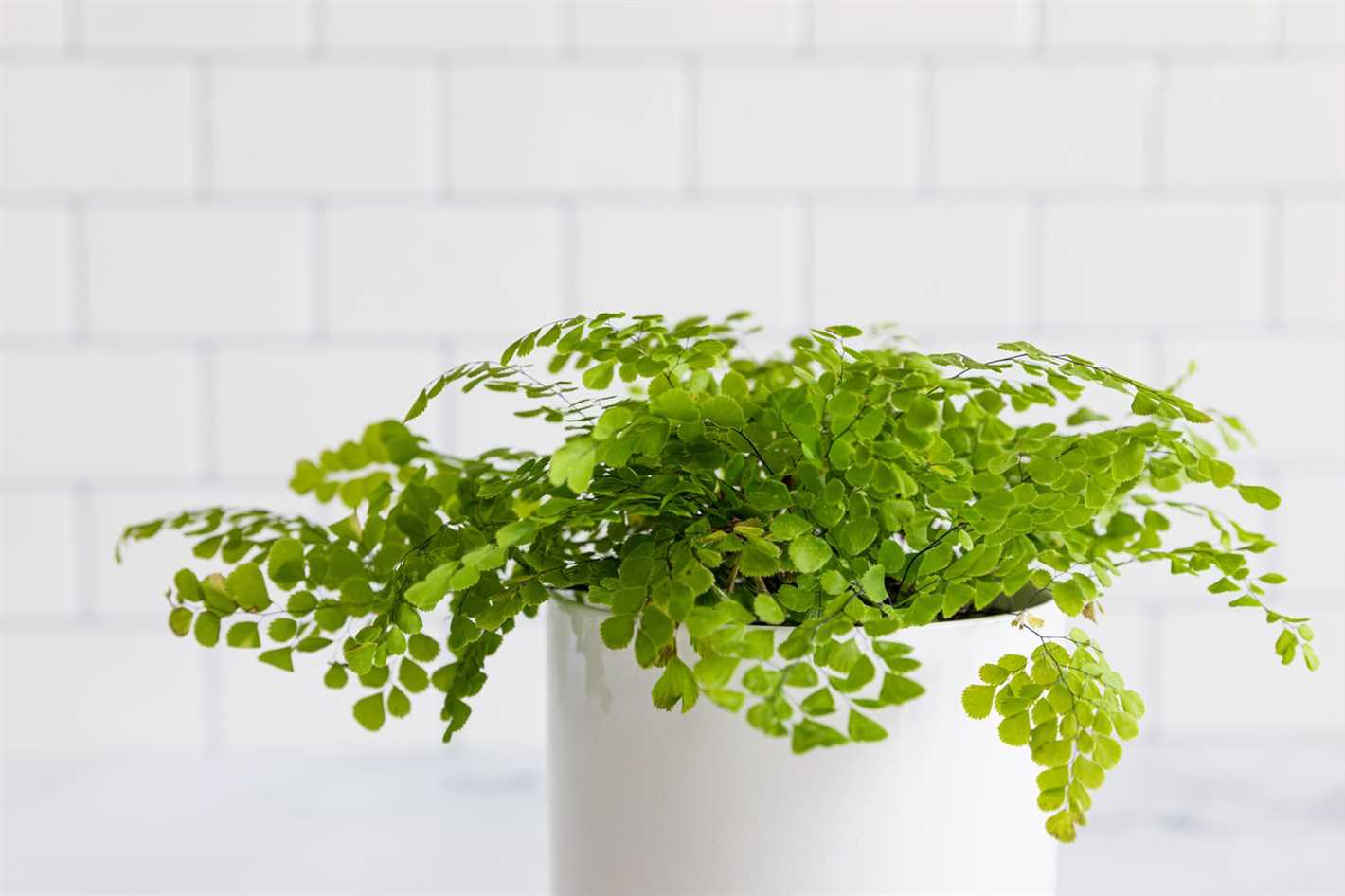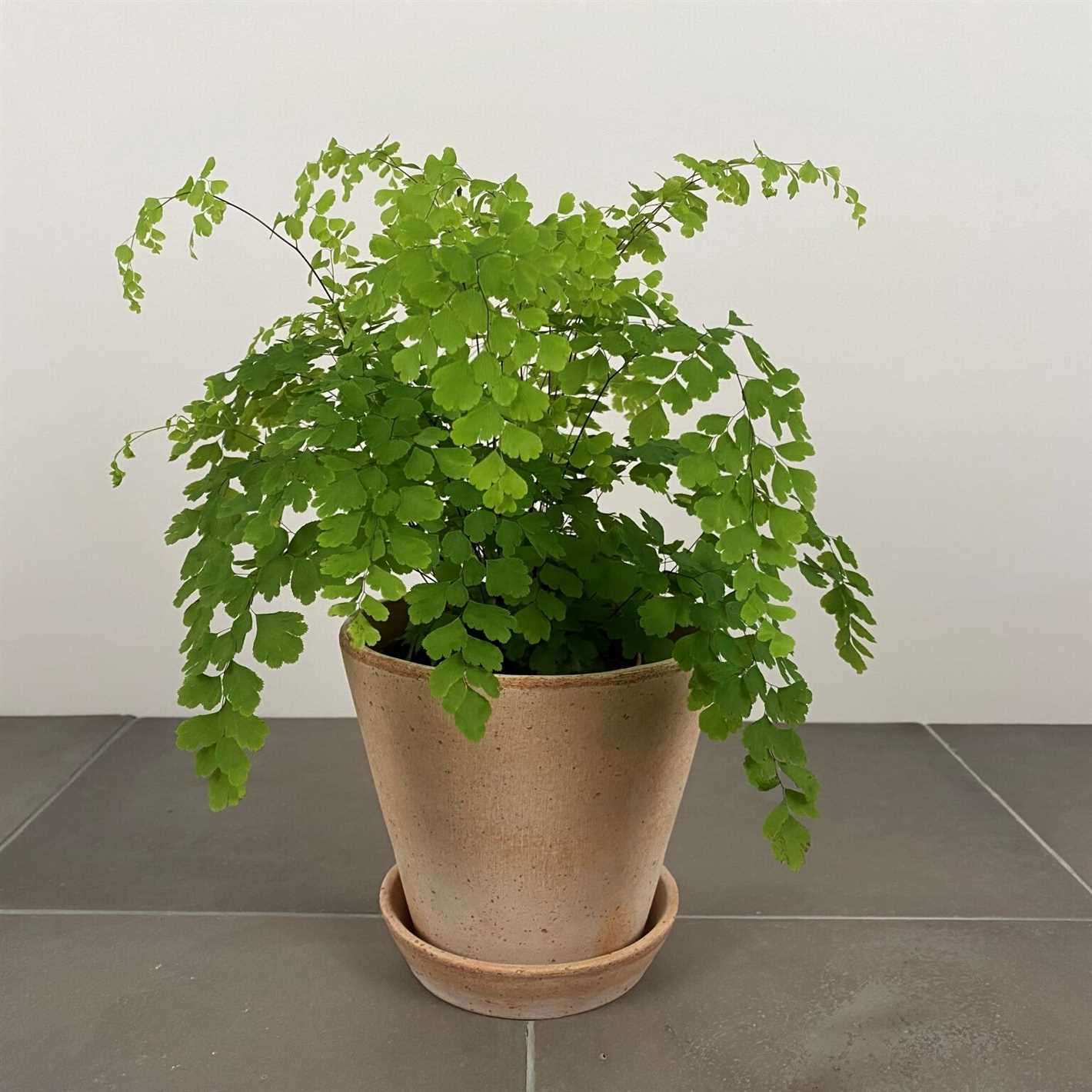- Choosing the Right Location for Your Adiantum Plant
- Watering Your Adiantum Plant
- Fertilizing Your Adiantum Plant
- 1. Choose the right fertilizer
- 2. Follow the recommended dosage
- 3. Fertilize during the growing season
- 4. Apply the fertilizer evenly
- 5. Monitor your plant’s response
- Providing the Right Light Conditions for Adiantum Plants
- Pruning and Propagating Adiantum Plants
- 1. Pruning
- 2. Propagating
- 2.1. Division
- 2.2. Spores
- Dealing with Common Pests and Diseases of Adiantum Plants
- Pests
- Diseases
- Q&A:
- How often should I water my Adiantum plant?
- What is the best location for my Adiantum plant?
- How do I propagate my Adiantum plant?
- Why are the leaves of my Adiantum plant turning brown and crispy?
- Can I grow my Adiantum plant in a terrarium?
- Video: How To Revive Your Maidenhair Fern

Adiantum, commonly known as maidenhair fern, is a popular houseplant that is valued for its delicate, feathery fronds and ability to thrive in low-light conditions. With its graceful appearance and easy-care nature, it is no wonder that Adiantum is a favorite among both experienced and novice gardeners.
When it comes to caring for Adiantum plants, there are a few key factors to keep in mind. First and foremost, it is important to provide the right amount of light. While Adiantum can tolerate low-light conditions, it prefers bright, indirect light. Placing your plant near a north or east-facing window is ideal. Avoid exposing it to direct sunlight, as this can scorch the fronds.
In addition to light, humidity is another crucial aspect of Adiantum care. This tropical plant thrives in high humidity environments, so it is beneficial to provide extra moisture. One way to increase humidity is to place the plant on a tray filled with water and pebbles. As the water evaporates, it creates a humid microclimate around the plant. Another option is to use a humidifier or mist the fronds regularly.
Tip: Adiantum is also sensitive to dry air, so avoid placing it near heating vents or drafts that can dry out the foliage.
Watering is another important aspect of Adiantum care. This plant prefers evenly moist soil, but it should never be allowed to sit in standing water. Water your Adiantum when the top inch of soil feels dry to the touch. Be sure to use room temperature water to avoid shocking the plant’s roots.
With proper care, your Adiantum plant will flourish and bring a touch of elegance to any space. By providing the right amount of light, humidity, and water, you can enjoy the beauty of this delicate houseplant for years to come.
Choosing the Right Location for Your Adiantum Plant
One of the key factors in successfully caring for your Adiantum plant is choosing the right location for it. Adiantum plants are native to tropical and subtropical regions, so they thrive in warm and humid conditions. Here are some important considerations when selecting a spot for your Adiantum plant:
- Indirect sunlight: Adiantum plants prefer bright but indirect sunlight. Direct sunlight can scorch their delicate leaves, so it’s best to place them in a spot where they can receive filtered or dappled sunlight.
- Avoid drafts: Adiantum plants are sensitive to drafts, so avoid placing them near air conditioning vents, fans, or windows that receive a lot of cold air. The ideal temperature for Adiantum plants is between 60-75°F (15-24°C).
- High humidity: Adiantum plants love humidity, so it’s important to provide them with adequate moisture in the air. You can increase humidity levels by placing a tray of water near the plant or by using a humidifier.
- Stable temperature: Adiantum plants prefer a stable temperature, so avoid placing them in areas with extreme temperature fluctuations, such as near doors, windows, or heating vents.
- Well-draining soil: Adiantum plants prefer well-draining soil that retains some moisture but doesn’t become waterlogged. Use a potting mix that is specifically formulated for ferns or amend regular potting soil with perlite or sand to improve drainage.
By selecting the right location for your Adiantum plant and providing it with the proper care, you can help ensure its healthy growth and beautiful foliage.
Watering Your Adiantum Plant
Proper watering is essential for the health and well-being of your Adiantum plant. Here are some tips to help you water your plant correctly:
- Adiantum plants prefer moist, but not waterlogged, soil. It’s important to find the right balance when watering.
- Check the top inch of soil before watering. If it feels dry to the touch, it’s time to water your plant.
- Water your Adiantum plant thoroughly until you see water draining out of the bottom of the pot. This helps ensure that the roots receive enough water.
- Avoid letting your plant sit in standing water, as it can lead to root rot. Make sure the pot has drainage holes to allow excess water to escape.
- During the growing season, typically spring and summer, you may need to water your Adiantum plant more frequently. Monitor the soil moisture to determine the watering frequency.
- In the winter months, when the plant is in its dormant period, reduce the watering frequency to prevent overwatering.
- Consider using room temperature or lukewarm water when watering your Adiantum plant. Avoid using cold or hot water, as extreme temperatures can harm the plant.
By following these watering tips, you can help ensure that your Adiantum plant thrives and stays healthy. Remember to observe your plant closely and adjust your watering routine as needed based on its individual needs.
Fertilizing Your Adiantum Plant


Fertilizing your Adiantum plant is essential for its overall health and growth. Here are some tips to consider when fertilizing your plant:
1. Choose the right fertilizer
When it comes to Adiantum plants, it is best to use a balanced liquid fertilizer that is specifically formulated for indoor houseplants. Look for a fertilizer with a balanced NPK ratio (nitrogen, phosphorus, and potassium) to ensure your plant receives all the necessary nutrients.
2. Follow the recommended dosage
Read the instructions on the fertilizer packaging carefully and follow the recommended dosage. Over-fertilizing can lead to fertilizer burn and damage the delicate fronds of your Adiantum plant. It is better to under-fertilize than to over-fertilize.
3. Fertilize during the growing season
The best time to fertilize your Adiantum plant is during the growing season, which is usually spring and summer. This is when your plant will be actively growing and will benefit the most from the added nutrients. Avoid fertilizing during the plant’s dormant period.
4. Apply the fertilizer evenly
Before applying the fertilizer, water your Adiantum plant thoroughly. This will help prevent fertilizer burn and ensure that the nutrients are more evenly distributed in the soil. Follow the instructions on the fertilizer packaging to determine the correct amount to use.
5. Monitor your plant’s response
After fertilizing your Adiantum plant, closely monitor its response. Look for signs of new growth, healthy fronds, and overall vitality. If you notice any negative effects, such as yellowing leaves or stunted growth, it may be a sign of over-fertilization or a nutrient imbalance. Adjust the fertilizer dosage accordingly.
Remember to always be cautious and avoid over-fertilizing your Adiantum plant. With the right fertilizer and proper care, your Adiantum plant will thrive and continue to grace your home with its beautiful foliage.
Providing the Right Light Conditions for Adiantum Plants
Adiantum plants, also known as the maidenhair fern, need the right amount of light to thrive. Here are some tips to provide the correct light conditions for your Adiantum plants:
- Bright Indirect Light: Adiantum plants prefer bright indirect light. Avoid placing them in direct sunlight as it can scorch their delicate fronds.
- Filtered Light: You can provide filtered light by placing your Adiantum plant near a sheer curtain or window with a light-filtering blind. This will help protect the plant from the harsh rays of the sun.
- North-Facing Windows: Adiantum plants thrive in environments with bright, indirect light. If possible, place your plant in a north-facing window to provide it with the ideal light conditions.
- Artificial Light: If you don’t have access to natural light or your home doesn’t have suitable windows, you can use artificial light sources to provide the necessary light for your Adiantum plant. Use fluorescent lights or specialized grow lights that emit a full spectrum of light.
Remember to monitor your Adiantum plant closely to ensure it is not receiving too much or too little light. Adjust the placement of the plant accordingly to provide the optimal lighting conditions for its growth and overall health.
Pruning and Propagating Adiantum Plants
Pruning and propagating adiantum plants are essential tasks for maintaining their health and promoting their growth. Here are some tips and techniques to help you with these tasks:
1. Pruning
Pruning adiantum plants is necessary to remove dead or yellowing fronds and encourage new growth. Follow these steps to prune your adiantum plant:
- Inspect the plant and identify any fronds that are brown, yellow, or wilted.
- Using a clean and sharp pair of pruning shears, carefully cut these fronds at the base of the stem.
- Make sure to avoid cutting any healthy fronds or damaging the main stem.
2. Propagating


Propagating adiantum plants is a great way to expand your collection or share them with others. There are two common methods for propagating adiantum plants:
2.1. Division
Division is a simple and effective method for propagating adiantum plants. Follow these steps to propagate your adiantum plant through division:
- Carefully remove the plant from its pot, making sure to keep the root ball intact.
- Gently separate the root ball into smaller sections, ensuring that each section has an equal amount of roots and fronds.
- Replant each divided section into its own pot with fresh potting soil.
- Water the newly divided plants thoroughly and place them in a shaded area until they establish roots.
2.2. Spores
Another method of propagating adiantum plants is through spores. Follow these steps to propagate your adiantum plant through spores:
- Find mature fronds that have developed brown spore patches on the undersides.
- Place a piece of paper or a plastic bag under the frond and gently brush the spores onto it.
- Prepare a container with a mixture of equal parts peat moss and perlite.
- Sprinkle the spores onto the soil surface and cover the container with a plastic bag to create a humid environment.
- Place the container in a warm and shaded area and mist it regularly to keep the soil moist.
- After a few weeks, tiny adiantum plants will start to emerge.
- Once the plants have a few fronds, carefully transplant them into individual pots with well-draining potting soil.
By following these pruning and propagating techniques, you can ensure the well-being and expansion of your adiantum plant collection. Remember to provide them with the appropriate care and ideal growing conditions to help them thrive.
Dealing with Common Pests and Diseases of Adiantum Plants
Adiantum plants are generally resilient and resistant to pests and diseases, but occasionally they can face some common issues. Here are some pests and diseases to watch out for, and how to deal with them:
Pests
- Aphids: These small insects suck sap from the leaves. Use a gentle insecticidal soap or neem oil spray to control the infestation. Regularly inspect your plants and remove any affected leaves.
- Scales: Scales are small insects that attach themselves to the leaves and stems, sucking sap and causing damage. Prune off heavily infested areas and use insecticidal soap to control the population.
- Spider mites: Spider mites are tiny pests that create webs on the leaves and suck the plant’s juices. Use a strong stream of water to wash them off the leaves or use insecticidal soap if necessary.
- Mealybugs: Mealybugs are small, white, cotton-like pests that infest the leaves and stems of plants. Apply rubbing alcohol or insecticidal soap to individual bugs with a cotton swab or use a spray for larger infestations.
Diseases
- Leaf spot: Leaf spot is a fungal disease that causes dark spots on the leaves. Remove and destroy affected leaves and ensure proper ventilation and good air circulation around the plant.
- Root rot: Overwatering can lead to root rot, causing the roots to become mushy and brown. Make sure your plant is not sitting in standing water and adjust watering habits accordingly. Consider repotting the plant in fresh, well-draining soil if necessary.
- Leaf blight: Leaf blight is another fungal disease that affects the leaves, causing them to wither and die. Remove and destroy infected leaves and ensure proper sanitation and care to prevent spreading.
Regularly inspecting your Adiantum plant for signs of pests or diseases is crucial to maintaining its health. Taking immediate action against any issues will help ensure that your plant stays beautiful and thriving.
Q&A:
How often should I water my Adiantum plant?
Adiantum plants prefer consistently moist soil, so water them whenever the top inch of soil feels dry. This may require watering your plant every few days or even every day in hot, dry weather.
What is the best location for my Adiantum plant?
Adiantum plants thrive in bright, indirect light. Avoid placing them in direct sunlight, as this can scorch their delicate leaves. Instead, find a spot near a window where they can receive bright, filtered light throughout the day.
How do I propagate my Adiantum plant?
Adiantum plants can be propagated through division or spore propagation. To divide the plant, carefully remove it from its pot and gently separate the roots. Replant the divided sections into separate pots with fresh potting soil. To propagate from spores, collect mature spores from the underside of the fronds and sprinkle them on damp soil. Cover the pot with a plastic bag to create a humid environment, and wait for the spores to germinate.
Why are the leaves of my Adiantum plant turning brown and crispy?
Brown and crispy leaves on an Adiantum plant are usually a sign of underwatering or low humidity. Make sure you are watering your plant regularly and providing adequate humidity by misting the leaves or placing a humidifier nearby. Also, ensure that your plant is not exposed to direct sunlight, as this can cause leaf burn.
Can I grow my Adiantum plant in a terrarium?
Adiantum plants can thrive in a terrarium as long as the conditions are suitable. Make sure the terrarium provides enough humidity and indirect light for the plant. Also, be cautious of overwatering in a closed terrarium, as excessive moisture can lead to root rot. Monitor the moisture levels and adjust your watering accordingly.
Video:
How To Revive Your Maidenhair Fern







